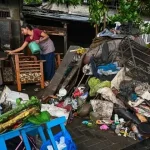Scholars in seminaries across several Beijing sections buckled down for online classes on Monday after officers called for residers in some of its hardest-hit areas to stay home, as COVID cases in China’s capital and nationally ticked advanced.
China is fighting multitudinous COVID-19 flare-ups, from Zhengzhou in central Henan fiefdom to Chongqing in the southwest. It reported 824 new original cases for Sunday, nearing the country’s diurnal epidemic peak in April.
It also recorded two deaths in Beijing, over from one on Saturday, which was China’s first since late May.
Guangzhou, a southern megacity of nearly 19 million people that’s battling the largest of China’s recent outbreaks, ordered a five- day lockdown for Baiyun, its most vibrant quarter. It also suspended dine- in services and shut night clubs and theatres in the megacity’s main business quarter.
The rearmost surge is testing China’s resoluteness to stick to adaptations it has made to its zero-COVID policy, which calls for metropolises to be more targeted in their clampdown measures and steer down from wide lockdowns and testing that have strangled the frugality and frustrated residers.
Asian share requests and oil painting prices slipped on Monday as investors fretted about the profitable fallout from the enhancing COVID situation in China, with the threat aversion serving bonds and the bone.
Beijing reported 962 new infections, over from 621 a day before. Its sprawling Chaoyang quarter, home to3.5 million people, prompted residers to stay home, with seminaries going online.
thoroughfares were quiet with residers prompted to work from home. Stores other than those dealing groceries appeared substantially shut.
“You can not go anywhere. Everything’s unrestricted. guests can not come, moreover. What can you do? You can do nothing,” said Jia Xi, 32, a medical assiduity salesperson.
Some seminaries in Haidian, Dongcheng and Xicheng sections also halted in- person tutoring.
REVERSAL OF APPROACH
Several Chinese metropolises began cutting routine community COVID- 19 testing last week, including the northern megacity of Shijiazhuang, which came the subject of hot enterprise that it could be a test bed for policy relaxation.
But late on Sunday, Shijiazhuang blazoned it would conduct mass testing in six of its eight sections over the coming five days after new diurnal original cases hit 641. It also encouraged residers to shop online and ordered some seminaries to suspend in- person tutoring.
“They lasted a week,” said one popular comment on Weibo on Shijiazhuang’s checks, which was among the most viewed motifs on the social media platform.
The People’s Daily review, the prophet of the Chinese Communist Party on Monday published another composition reiterating the need to catch infections beforehand but to avoid taking a “one- size-fits- all” approach, its eighth similar piece since China blazoned its 20 acclimated measures onNov. 11.
The National Health Commission on Monday published more detailed guidance on how these measures would be applied to testing, the delineation and operation of threat areas as well as home insulation practices.
” FEELING THE monuments”
China’s recent sweats to make its COVID-19 checks more targeted have sparked investor expedients of a more significant easing indeed as China faces its first downtime battling the largely transmittable Omicron variant.
Numerous judges anticipate such a shift to begin only in March or April, still, with the government arguing that President Xi Jinping’s hand zero-COVID policy saves lives and is necessary to help the healthcare system being overwhelmed.
Experts argue full continuing requires a massive vaccination supporter trouble and a change in messaging in a country where the complaint remains extensively stressed. Authorities say they plan to make further sanitarium capacity and fever conventions to screen cases and are formulating a vaccination drive.
Oxford Economics said it only expects an exit from zero-COVID in the alternate half of 2023, with vaccination rates for the senior still comparatively low.
“From an epidemiological and political perspective, we don’t suppose the country is ready yet to open up,” it said in a Monday report.
Hao Hong, principal economist at GROW Investment Group, said in a separate note a gradational and managed continuing may formerly be underway, with rounds of back and forth as China “crosses the swash while feeling the monuments”.
“Despite the mounting challenges, it isn’t a question of whether China will renew, but a question of over how long a period and how stylish to manage to minimize healthcare costs and implicit lives lost,” he said.








